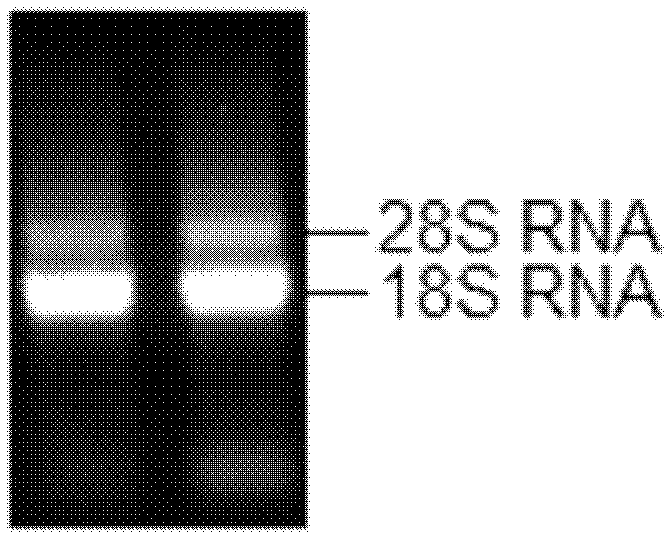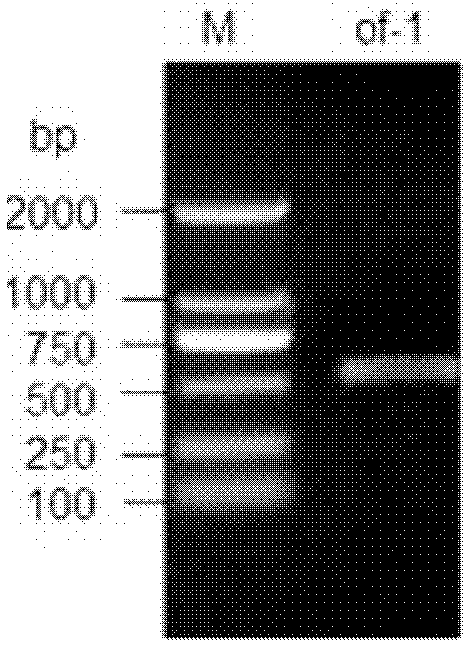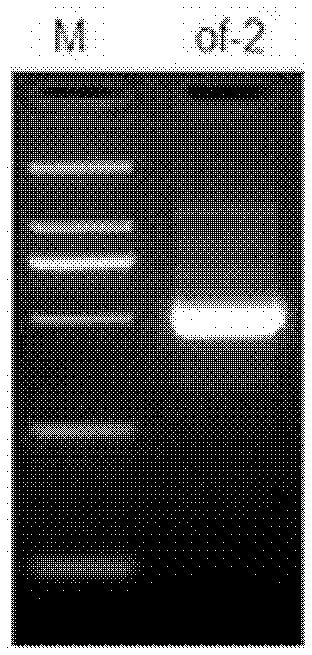Ofoga gene of β-n-acetylglucosyl hydrolase from the Asian corn borer and its application
A technology of Asian corn borer and aminoacetyl, applied in the field of genetic engineering, can solve the problems of chemical pesticides without specific effects and time-consuming and laborious application methods
- Summary
- Abstract
- Description
- Claims
- Application Information
AI Technical Summary
Problems solved by technology
Method used
Image
Examples
Embodiment 1
[0025] Example 1 Obtaining of the Ostrinia officinalis β-N-acetylglucosyl hydrolase (OfOGA) gene
[0026] 1. Extraction of totalRNA from the 5th instar larvae of Ostrinia officinalis
[0027] Total RNA was extracted from the 5th instar larvae of Ostrinia officinalis using RNAisoplus (Dalian Bao Biological Company, Code No. D9108A) to obtain the total RNA.
[0028] Take 1ul of the above-mentioned total RNA of Ostrinia officinalis and carry out 1% agarose gel electrophoresis, the result is as follows figure 1 , figure 1 Shown is the gel electrophoresis analysis of the total RNA extracted from the 5th instar larvae of Ostrinia officinalis. Two of the RNA samples have clear results and meet the quality requirements and are suitable for the next experiment.
[0029] 2. RT-PCR experiment
[0030] Using the total RNA of the 5th instar larvae of Ostrinia officinalis as a template, reverse transcription was carried out to synthesize cDNA.
[0031] The primers used for gene transfer...
Embodiment 2
[0143] Example 2 Expression of Ostrinia officinalis β-N-acetylglucosaminyl hydrolase (OfOGA)
[0144] 1. Escherichia coli expression system to obtain soluble expression products
[0145] The OfOGA gene was cloned into the NcoI and EcoRI sites of the vector pET-28a(+) (Novagen Company), and 6 His tags (CATCATCATCATCATCAT) were added to the C-terminus of the protein to construct the expression vector pET28a-OfOGA-6His.
[0146]
[0147] The detailed steps are:
[0148] 1. Design NcoI and EcoRI restriction sites on the primers of OfOGA. After the PCR reaction, use NcoI and EcoRI to digest; pET-28a(+) is digested with NcoI and EcoRI; use DNALigationKit (Dalian Bao Biological Company, Code No. D6020A) Solution I in the kit, respectively ligated the digested PCR product with the digested pET-28a(+).
[0149] 2. Transform E.coliDH5α, screen positive recombinants, identify by enzyme digestion and determine the DNA sequence correctly, then transfer into E.coliBL21(DE3), and identi...
PUM
 Login to View More
Login to View More Abstract
Description
Claims
Application Information
 Login to View More
Login to View More - R&D
- Intellectual Property
- Life Sciences
- Materials
- Tech Scout
- Unparalleled Data Quality
- Higher Quality Content
- 60% Fewer Hallucinations
Browse by: Latest US Patents, China's latest patents, Technical Efficacy Thesaurus, Application Domain, Technology Topic, Popular Technical Reports.
© 2025 PatSnap. All rights reserved.Legal|Privacy policy|Modern Slavery Act Transparency Statement|Sitemap|About US| Contact US: help@patsnap.com



